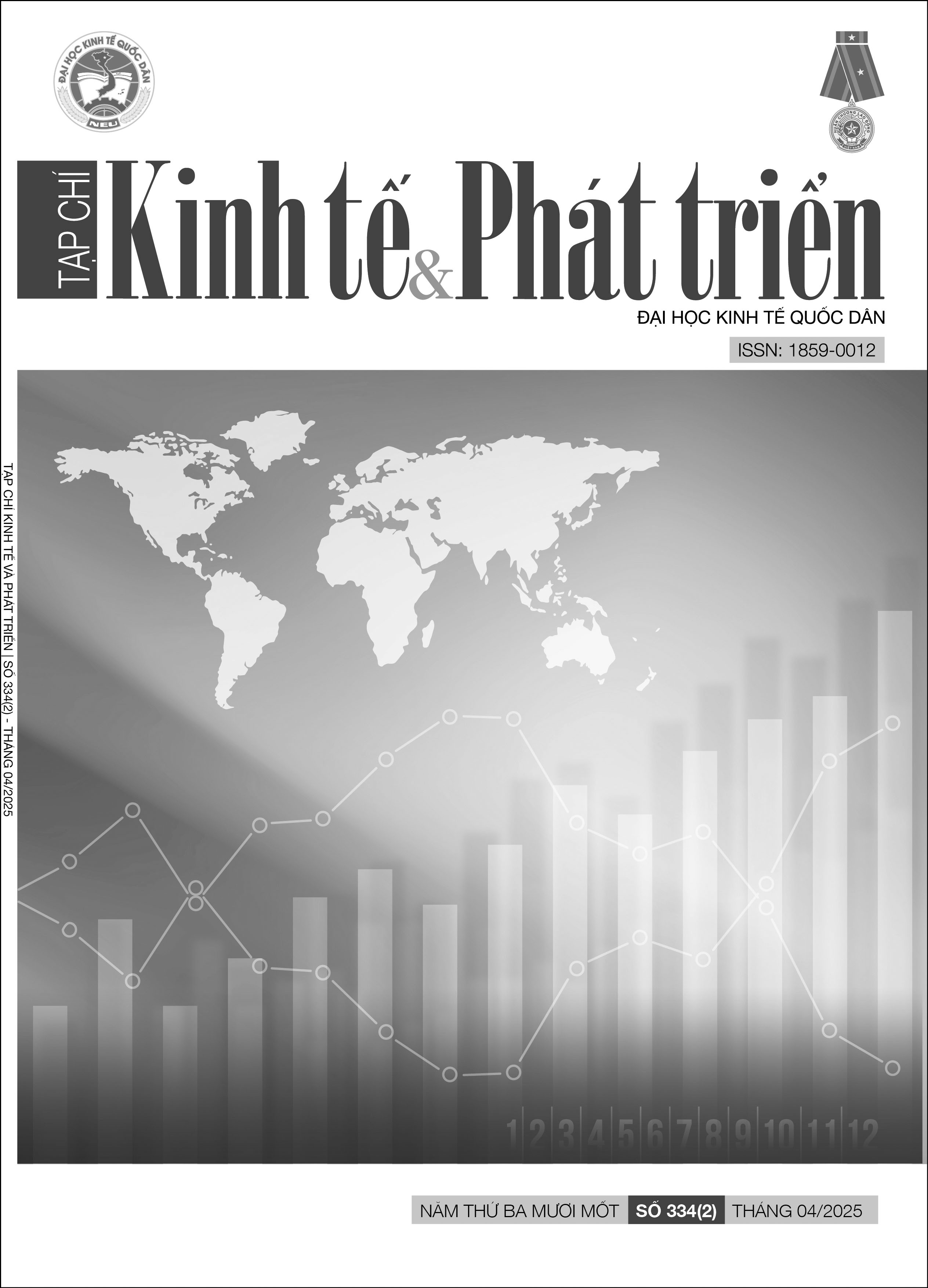Tác động của độ mở kinh tế đến rủi ro ngân hàng thương mại Việt Nam: Vai trò của kiểm soát tham nhũng
DOI:
https://doi.org/10.33301/JED.VI.2251Từ khóa:
Độ mở kinh tế, rủi ro ngân hàng, tham nhũng, Việt NamTóm tắt
Bài nghiên cứu kiểm định tác động của độ mở kinh tế, bao gồm độ mở tài chính và độ mở thương mại, đến rủi ro của ngân hàng thương mại Việt Nam trong giai đoạn 2009 – 2023. Đồng thời, tác giả cũng xem xét vai trò của kiểm soát tham nhũng trong tác động của mở cửa kinh tế đến rủi ro của các ngân hàng. Kết quả hồi quy từ phương pháp ước lượng bình phương tối thiểu tổng quát khả thi (FGLS) và mô hình mô men tổng quát (SGMM) cho thấy mở cửa kinh tế làm tăng rủi ro cho các ngân hàng thương mại Việt Nam. Tuy nhiên, nếu vấn đề tham nhũng được kiểm soát tốt sẽ góp phần giảm thiểu tác động tiêu cực của toàn cầu hóa đến rủi ro ngân hàng.
Tài liệu tham khảo
Alamgir Hossain, S., Moudud-Ul-Huq, S., & Kader, M. B. (2020), ‘Impact of trade openness on bank risk-taking behavior: Evidence from a developing country’, Cogent Economics & Finance, 8(1), 1765468.
Allen, F. (2000), Comparing financial systems, MIT Press.
Ashraf, B. N., Arshad, S., & Yan, L. (2017), ‘Trade openness and bank risk-taking behavior: Evidence from emerging economies’, Journal of Risk and Financial Management, 10(3), 15.
Beck, T., Demirgüç-Kunt, A., & Levine, R. (2006), ‘Bank supervision and corruption in lending’, Journal of monetary Economics, 53(8), 2131-2163.
Berger, A. N., El Ghoul, S., Guedhami, O., & Roman, R. A. (2017), ‘Internationalization and bank risk’, Management Science, 63(7), 2283-2301.
Bộ Kế hoạch và Đầu tư (2025), Báo cáo nhanh tình hình thu hút đầu tư nước ngoài tại Việt Nam và đầu tư của Việt Nam ra nước ngoài năm 2024, Cập nhật ngày 09/01/2025 tại: https://www.mpi.gov.vn/portal/Pages/2025-1-6/Tinh-hinh-thu-hut-dau-tu-nuoc-ngoai-tai-Viet-Nam-v5506hz.aspx.
Boyd, J. H., & De Nicolo, G. (2005), ‘The theory of bank risk taking and competition revisited’, The Journal of finance, 60(3), 1329-1343.
Bui, D. T., & Bui, T. M. H. (2019), ‘How does institutional development shape bank risk-taking incentives in the context of financial openness?’, Pacific-Basin Finance Journal, 58, 101209.
Demirgüç-Kunt, A., & Detragiache, E. (1998), Financial liberalization and financial fragility (No. 1917), World Bank Publications.
Diamond, D. W. (1984), ‘Financial intermediation and delegated monitoring’, The review of economic studies, 51(3), 393-414.
Dinger, V., & Te Kaat, D. M. (2020), ‘Cross-border capital flows and bank risk-taking’, Journal of Banking & Finance, 117, 105842.
Frame, W. S., Mihov, A., & Sanz, L. (2020), ‘Foreign investment, regulatory arbitrage, and the risk of US banking organizations’, Journal of Financial and Quantitative Analysis, 55(3), 955-988.
Goldfajn, Ilan & Valdés, Rodrigo. (1995), ‘Balance-of-Payments Crises and Capital Flows: the Role of Liquidity’, Mimeo, Massachussets Institute of Technology.
Haufler, A., & Wooton, I. (2021), ‘Multinational banks in regulated markets: Is financial integration desirable?’, Canadian Journal of Economics/Revue canadienne d'économique, 54(4), 1811-1841.
Kose, M. A. (2002), ‘Explaining business cycles in small open economies:‘How much do world prices matter?’, Journal of International Economics, 56(2), 299-327, DOI: 10.1016/S0022-1996(01)00120-9.
Lane, P. R., & Milesi-Ferretti, G. M. (2007), ‘The external wealth of nations mark II: Revised and extended estimates of foreign assets and liabilities’, 1970–2004, Journal of international Economics, 73(2), 223-250.
Leff, N. H. (1964), ‘Economic development through bureaucratic corruption’, American behavioral scientist, 8(3), 8-14, DOI: 10.1177/000276426400800303.
Li, Z., & Moreira, F. (2024), ‘Financial openness, liability composition of banks, and bank risk: International evidence’, Journal of International Financial Markets, Institutions and Money, 97, 102066.
Lui, F. T. (1985), ‘An equilibrium queuing model of bribery’, Journal of political economy, 93(4), 760-781, DOI: 10.1086/ 261329.
Ma, Y., & Yao, C. (2022), ‘Openness, financial structure, and bank risk: International evidence’, International review of financial analysis, 81, 102065.
McKinnon, R. I., & Pill, H. (1997), ‘Credible economic liberalizations and overborrowing’, The American Economic Review, 87(2), 189-193.
McLemore, P., Mihov, A., & Sanz, L. (2022), ‘Global banks and systemic risk: The dark side of country financial connectedness’, Journal of International Money and Finance, 129, 102734.
Nguyen, D. T. T., Diaz-Rainey, I., Roberts, H., & Le, M. (2021), ‘Loans from my neighbours: East Asian commercial banks, financial integration, and bank default risk’, International Review of Financial Analysis, 74, 101659.
Pesaran, M. H., Schuermann, T., & Weiner, S. M. (2004), ‘Modeling regional interdependencies using a global error-correcting macroeconometric model’, Journal of Business & Economic Statistics, 22(2), 129-162.
Pham, T. T., Dao, L. K. O., & Nguyen, V. C. (2021), ‘The determinants of bank’s stability: a system GMM panel analysis’, Cogent Business & Management, 8(1), 1963390.
Rahman, M. M., Begum, M., Ashraf, B. N., & Masud, M. A. K. (2020), ‘Does trade openness affect bank risk-taking behavior? Evidence from BRICS countries’, Economies, 8(3), 75, DOI: 10.3390/economies8030075.
Razin, A., Sadka, E., & Coury, T. (2003), ‘Trade openness, investment instability and terms-of-trade volatility’, Journal of International Economics, 61(2), 285-306, DOI: 10.1016/S0022-1996(03)00014-X.
Saif-Alyousfi, A. Y. (2023), ‘Impact of FDI inflows on bank loans in Gulf Cooperation Council economies: an empirical insight’, International Journal of Emerging Markets, 18(2), 505-524.
Shleifer, A., & Vishny, R. W. (1993), ‘Corruption’, The quarterly journal of economics, 108(3), 599-617, DOI: 10.2307/2118402.
Tô Vĩnh Sơn (2022), ‘Tác động của cạnh tranh đến rủi ro của các ngân hàng thương mại Việt Nam’, Tạp chí Nghiên cứu Tài chính-Marketing, 13(3), 53-65, DOI: 10.52932/jfm.vi69.260.
Wang, W., & Qu, Z. (2024), ‘Capital market opening and commercial bank risk: Evidence from “Shanghai–Hong Kong Stock Connect”’, Finance Research Letters, 59, 104827.





